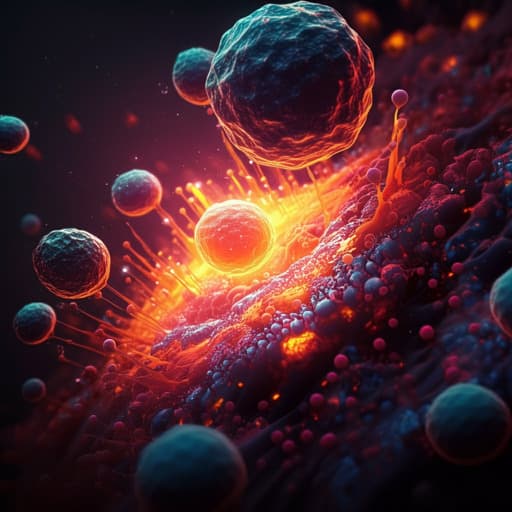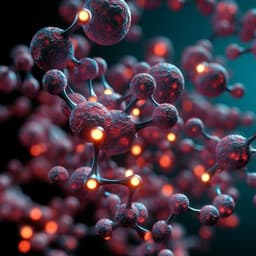
Medicine and Health
CAR T-Cell Therapy for Cancer: Latest Updates and Challenges, with a Focus on B-Lymphoid Malignancies and Selected Solid Tumours
H. K. Tang, C. Tang, et al.
Explore the exciting advances in CAR T-cell therapy, which holds future promise for treating common epithelial cancers despite challenges in solid tumors. This review, carried out by Hiu Kwan Tang, Carolyn Tang, Bo Wang, Hui Xian Tan, Muhammad Adeel Sarwar, Bahaaeldin Baraka, Tahir Shafiq, and Ankit R Rao, highlights the biology, mechanisms, and clinical data surrounding this innovative treatment approach.
~3 min • Beginner • English
Introduction
Cancer immunotherapy has transformed the management of advanced malignancies but even combination checkpoint blockade (e.g., anti-CTLA-4 plus anti-PD-1) does not yield long-term survival beyond roughly 60% in melanoma and is associated with significant, sometimes irreversible, immune-related toxicities. Predictive biomarkers such as PD-L1 and tumor mutational burden are imperfect, and mechanisms of resistance limit benefit across cancer types. While a cellular therapy (Sipuleucel-T) received approval in 2010, broad adoption was limited. Since 2017, CAR T-cell therapies targeting CD19 have been approved and their use has expanded. This review outlines limitations of current immunotherapies, the need for new approaches, CAR T-cell biology and mechanism, clinical data for anti-CD19 CAR T cells, associated toxicities, and prospects for extending CAR T therapy to epithelial solid tumors.
Literature Review
The review synthesizes advances and constraints in contemporary immunotherapy. It highlights durable responses with checkpoint inhibitors across cancers (e.g., 54% long-term OS with combined anti-CTLA-4/PD-1 in melanoma; 43% ORR and 26.3% 5-year OS with pembrolizumab monotherapy in high PD-L1 NSCLC; superior outcomes for nivolumab/ipilimumab versus sunitinib in RCC; benefit of atezolizumab in platinum-treated urothelial carcinoma). It details toxicities from non-antigen-specific immune activation (autoimmunity, colitis, endocrine and neurologic events) and the exclusion of autoimmune populations from pivotal trials. Biomarkers like PD-L1 and TMB are variably predictive and not broadly implemented; emerging factors (microbiome, immune signatures) require further validation. The review discusses resistance mechanisms (e.g., alternative checkpoints LAG-3/TIM-3, MHC downregulation, Treg/MDSC upregulation) and combinatorial strategies, including local immunostimulatory approaches (oncolytic therapy, innate agonists) to convert immune-cold to immune-hot tumors.
Methodology
As a narrative review, no primary clinical experiments were conducted. The paper details the principles and processes of adoptive T-cell therapy and CAR T-cell engineering as background methodology: (1) Adoptive T-cell therapy (ACT) involves lymphodepleting conditioning (e.g., cyclophosphamide ± fludarabine), infusion of tumor-reactive T cells (historically TILs), and cytokine support (IL-2) to foster expansion and persistence, with evidence of efficacy in melanoma. (2) CAR T-cell biology: CARs comprise an extracellular antigen-recognition scFv, transmembrane domain (often CD28), and intracellular signaling domains (CD3ζ with co-stimulatory modules such as CD28 or 4-1BB). Generations progressed from CD3ζ-only (first) to incorporation of costimulation (second), dual costimulation (third), and cytokine-secreting TRUCKs (fourth). Logic-gated designs (AND/NOT) and inhibitory modules aim to enhance specificity and safety. Multi-target strategies (sequential/double transduction, bicistronic/bivalent constructs) address antigen escape. (3) Manufacturing: Clinical-grade CAR T cells are produced from leukapheresis-derived PBMCs, activation (anti-CD3/CD28 beads), gene transfer (typically self-inactivating lentiviral or γ-retroviral vectors; emerging nonviral CRISPR/Cas9 systems), and expansion to target doses (often ~3×10^8 cells). Release testing includes CAR expression and antigen-specific IFN-γ production. Substrate selection (CD4/CD8/αβ/γδ T cells, NK/NKT cells) and off-the-shelf allogeneic approaches (e.g., γδ T cells) are under investigation. Safety features include suicide switches (e.g., inducible caspase-9).
Key Findings
- CD19 CAR T in B-lymphoid malignancies:
- Pediatric/young adult B-ALL (tisa-cel, ELIANA): 80% remission at 3 months; 1-year OS 79%; 3-year OS 63% and PFS 50%.
- Adult B-ALL (brexu-cel, ZUMA-3): 71% remission at ~16 months’ follow-up; 2/55 treatment-related deaths reported.
- DLBCL (axi-cel, ZUMA-1): 40% CR at 15 months; OS 52% at 18 months. DLBCL (tisa-cel, JULIET): 40% CR at 14 months; OS 65% at 12 months. DLBCL (liso-cel, TRANSCEND): 53% CR at 18 months. Real-world retrospective data show higher response with CAR T but similar durability vs salvage therapy after covariate adjustment.
- Follicular lymphoma (axi-cel, ZUMA-5): ORR 94%, CR 80%, OS 93% at 19 months. FL (tisa-cel, ELARA): CR 65% (preliminary).
- Multiple myeloma: ide-cel (KarMMa) ORR 73%, CR 33%, median PFS 8.8 months, MRD-negative 26%; cilta-cel (CARTITUDE-1) CR 82.5% at 2 years.
- Toxicities and management:
- CRS: common within 7 days; driven by TNF-α, IFN-γ, IL-1, with GM-CSF central to myeloid activation. Managed with supportive care, tocilizumab (IL-6R), anakinra (IL-1), corticosteroids (with caution), and investigational dasatinib to transiently dampen TCR signaling.
- ICANS: neurotoxicity (tremor, delirium, aphasia), rare fatal cerebral edema (2–3%); high-dose steroids are mainstay; CD19 expression on brain mural cells may contribute.
- Other: infusion reactions including rare anaphylaxis, tumor lysis syndrome; on-target effects like B-cell aplasia/hypogammaglobulinemia.
- Solid tumors: challenges include antigen selection (on-target/off-tumor expression), trafficking barriers (endothelium/ECM), and limited persistence.
- Neuroblastoma (anti-GD2 CAR with iCasp9, OX40/4-1BB): ORR 63%; at full dose, 3-year RFS 36% and OS 60%; one high-grade toxicity reversed by suicide switch; median persistence ~3 months (up to 30 months).
- HCC (anti-GPC3 CAR): in 13 HBV+ HCC patients, 2 PR and 1 prolonged SD; median OS 40 weeks; one CRS-related death; CAR persistence median 19 days.
- CD133 CAR (HCC/pancreas/CRC): 3/23 PR; 14/23 SD; median PFS 5 months (7 months in HCC); early pancytopenia due to CD133 on progenitors; OS not reported.
- Pancreatic cancer (mesothelin mRNA CAR, no lymphodepletion): 2 SD (3.8 and 5.4 months), 1 complete metabolic response of liver mets; no CRS/ICANS.
- Mesothelin CAR (lentiviral) in ovarian/pancreatic/mesothelioma: limited activity (median PFS 2.1 months; 3/8 SD ≥3 months); evidence of tumor trafficking; no serosal on-target toxicity.
- Regional delivery: intrapleural mesothelin CAR with pembrolizumab yielded median OS 24 months in pleural malignancies; intra-arterial anti-CEA CAR plus radioembolization in CEA+ liver mets showed biomarker responses and TME changes but short median OS (8–11 months).
- GBM: locoregional IL13Rα2 CAR led to a near 8-month complete response in one case with steroid cessation.
- Prostate cancer: PSMA CAR armored with dominant-negative TGF-β showed PSA declines >30% in 3/13 mCRPC patients; one fatal CRS.
- Implementation challenges: manufacturing success ~80%, risk of patient deterioration during production, high costs, need for intensive toxicity management infrastructure.
Discussion
The review integrates clinical data demonstrating that CAR T cells have transformed outcomes in relapsed/refractory CD19+ B-lymphoid malignancies and BCMA+ myeloma, offering deep and sometimes durable remissions where conventional therapies fail. Nevertheless, translation to common epithelial solid tumors is constrained by target antigen specificity (risk of on-target/off-tumor toxicity), barriers to T-cell trafficking and infiltration, immunosuppressive microenvironments, and limited CAR T persistence/memory formation. Findings emphasize the critical importance of safety engineering (e.g., suicide switches, logic-gating, regional delivery) and combinatorial approaches (e.g., checkpoint blockade, modulation of myeloid/Treg compartments, anti-IDO/PD-L1 strategies). Early successes in neuroblastoma and signals in HCC, GBM, pleural malignancies, and prostate cancer suggest niches where CAR T can be impactful, particularly with optimized delivery routes and armored constructs. However, the lack of randomized comparative trials in hematologic indications and modest efficacy in many solid tumors underscore the need for rigorous evaluation to define true benefit beyond selection bias.
Conclusion
CAR T-cell therapy is an important addition to cancer immunotherapy, with established efficacy in B-cell malignancies and multiple myeloma, but significant gaps remain: few randomized comparative data, complex manufacturing with incomplete success rates, high costs, and potentially severe toxicities (CRS/ICANS). In solid tumors, feasibility and safety have been shown in small studies, but efficacy is generally limited, likely due to antigen specificity challenges, trafficking barriers, and limited persistence. Future directions include integrating safety switches (e.g., inducible caspase-9), logic-gated and multi-target CARs, armored designs to counter immunosuppression, optimized lymphodepletion and cytokine support, regional delivery (intrapleural/intratumoral/intra-arterial), and rational combinations with checkpoint inhibitors and other modulators of the tumor microenvironment. Off-the-shelf platforms (e.g., γδ T/NK CARs) and strategies to enhance memory formation may improve accessibility and durability of responses.
Limitations
Key limitations highlighted include the paucity of randomized, comparative trials for approved hematologic indications; manufacturing constraints with approximately 80% success and consequent challenges for intent-to-treat analyses; logistical delays risking clinical deterioration before infusion; high costs and need for specialized infrastructure; limited predictive biomarkers; and in solid tumors, modest activity, on-target/off-tumor toxicity risk, trafficking barriers, and limited persistence/memory differentiation of CAR T cells.
Related Publications
Explore these studies to deepen your understanding of the subject.







